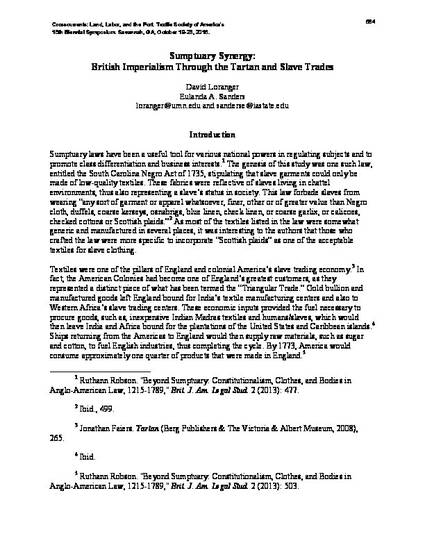
Crosscurrents: Land, Labor, and the Port. Textile Society of America’s 15th Biennial Symposium. Savannah, GA, October 19-23, 2016.
Sumptuary laws have been a useful tool for various national powers in regulating subjects and to promote class differentiation and business interests. The genesis of this study was one such law, entitled the South Carolina Negro Act of 1735, stipulating that slave garments could only be made of low-quality textiles. These fabrics were reflective of slaves living in chattel environments, thus also representing a slave’s status in society. This law forbade slaves from wearing “any sort of garment or apparel whatsoever, finer, other or of greater value than Negro cloth, duffels, coarse kerseys, osnabrigs, blue linen, check linen, or coarse garlix, or calicoes, checked cottons or Scottish plaids.” As most of the textiles listed in the law were somewhat generic and manufactured in several places, it was interesting to the authors that those who crafted the law were more specific to incorporate “Scottish plaids” as one of the acceptable textiles for slave clothing. Textiles were one of the pillars of England and colonial America’s slave trading economy. In fact, the American Colonies had become one of England’s greatest customers, as they represented a distinct piece of what has been termed the “Triangular Trade.” Gold bullion and manufactured goods left England bound for India’s textile manufacturing centers and also to Western Africa’s slave trading centers. These economic inputs provided the fuel necessary to procure goods, such as, inexpensive Indian Madras textiles and humans/slaves, which would then leave India and Africa bound for the plantations of the United States and Caribbean islands. Ships returning from the Americas to England would then supply raw materials, such as sugar and cotton, to fuel English industries, thus completing the cycle. By 1773, America would consume approximately one quarter of products that were made in England.
Available at: http://works.bepress.com/david-loranger/6/

Copyright 2016 David Loranger & Eulanda A. Sanders